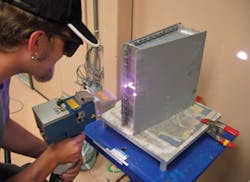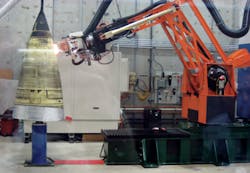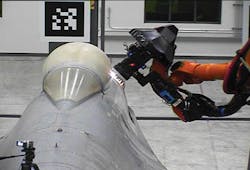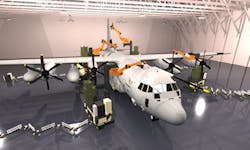DoD programs lead the way
James J. Arthur and Georgette C. Nelson
The Department of Defense (DoD) operates major depot maintenance facilities (depots) that perform repair, testing, and remanufacturing operations for all of the weapon systems and support equipment that are possessed by the US military. The current methods utilized by these depots for the removal of DoD coatings are costly, time consuming, and labor-intensive, cause substrate damage, and result in undesirable environmental conditions. Large quantities of hazardous waste are commonly generated from current methods and typically result in high disposal costs and environmental regulatory scrutiny. Wastes that are associated with coating removal include liquid paint removers, contaminated rinse water from chemical stripping operations, and media waste from a variety of blasting processes that are utilized.
Laser coating removal is an ablative process that can be applied to a variety of substrates, including metal, composites, plastics, and glass. Laser energy is focused onto the surface and is absorbed into the coating, resulting in decomposition and removal of the coating and causing only a minimal increase in substrate temperature. The key advantages that interest the DoD in the use of lasers for coating removal include their non-contact nature and the fact that they use no secondary medium that contributes to waste streams. For more than 20 years, the DoD has been actively pursuing laser coating removal as an alternative process due to its potential to reduce costs, reduce waste, and increase weapon system readiness. Laser coating removal technology has matured over this time. Early systems were one of a kind, requiring specialized parts and related maintenance at a high cost. More applications continue to be identified and systems transitioned as the laser systems' size and cost decrease, and reliability increases. This article presents some of the common applications and major DoD programs that have led to the advancement of this technology.
Small area applications
An initial focus area of investigation for the DoD was handheld lasers to be used as a supplementary de-coating method to allow operators to effectively strip the complex areas of parts that are inaccessible using other de-coating technologies. Independent studies were conducted by the US Air Force (USAF), Navy, Army, and Coast Guard to determine the effectiveness and usability of various commercially available handheld laser systems (see FIGURE 1). Testing and validation on the effects associated with coating removal on the specific materials of interest were performed for each of these DoD agencies. These studies included evaluation of various commercially available pulsed carbon dioxide (CO2), neodymium:yttrium, aluminum, garnet (Nd:YAG), and diode laser systems ranging in power between 40 and 500 W. These studies have resulted in each Service procuring commercially available Nd:YAG laser systems produced by various vendors.
Large area applications
One region of focus for coatings removal was applying high power lasers to large area coating removal. Ogden Air Logistics Complex (OO-ALC) at Hill Air Force Base (AFB) in Ogden, UT, was one of the early adopters of this technology. The laser automated decoating system (LADS) was a custom-engineered system that was implemented at OO-ALC for depainting aircraft nose radomes. This system consisted of a pulsed CO2 laser with a 30 J/pulse energy rating, a pulse length of 2.0 µs, and a maximum pulse rate of 150 pulses/s. The radome was affixed to a device that rotated as the laser beam ablated the paint from the surface. The CO2 laser generated a 0.5 in. to 2 in. wide pulse beam that was guided by previously recorded geometric analysis data. During coating removal, the surface temperature of the radome never exceeded 170°F. This system was installed at OO-ALC in 1995 and was proven to be an effective coating removal tool. After more than 10 years of operation, the system became outdated and expensive to maintain. It was ultimately decommissioned in 2008 and replaced by the LADS II system (FIGURE 2).
The LADS II system was designed to process A-10, F-16, and C-130 aircraft radomes. To maximize the system's usage, it can also process various other parts that are removed from the aircraft during depot maintenance. This system is based on an 8 kW continuous wave (CW) CO2 laser that is delivered to the work surface using a custom hollow robotic arm mounted on a 30-foot-long rail that allows processing of long parts. When compared to the original LADS system, the LADS II demonstrated improvements in power efficiency, power consumption, gas consumption, and maintenance costs. The LADS II also demonstrated significantly faster strip times than the original system: 30 minutes versus 6 hours. The drastically improved strip times allowed for a reduction in total processing time for radomes and for more parts to be processed through the system.
Helicopter rotor blade maintenance is another major area of decoating work for the DoD. In 1995, the US Army at the Corpus Christi Army Depot (CCAD) in Texas developed and implemented a laser coating removal system to perform this task. This system utilized a 2-kW, 200 Hz pulsed CO2 laser system that was mounted on a robotic arm that moved along the rotor blade to remove topcoats and rain erosion coatings. This system removed paint, primer, adhesive, and an abradable coating. This system was equipped with a spectral camera that provided real-time monitoring of the laser and the progress of paint removal. This one-of-a-kind system was implemented in 1995, but has since been decommissioned, primarily due to maintenance costs to keep the system operational.
More recently, the US Navy's Naval Undersea Warfare Center Keyport worked with several partners to develop the automatic rotor blade stripping system (ARBSS) that is installed at the Navy's Fleet Readiness Center-East (FRC-East) at Cherry Point, NC. The ARBSS was designed to strip coatings from the rotor blades of H-53 and H-60 helicopters that are used by the US Navy and US Marine Corps. This system combines a closed loop color control laser work head with an industrial robotic system. It employs three color-selective lasers that operate simultaneously to automatically strip rotor blades. A commercial robotic arm mounted on a 30-foot track manipulates a laser stripping head over all areas of the rotor blade surface during paint removal operations. It controls all aspects of the workcell, including fixturing, laser equipment, laser head communications, and monitoring sensors. The ARBSS provides a significant savings over the previous manual process. The ARBSS can strip a rotor blade in 4 to 6 hours, depending on the thickness of the paint, as compared to the 22 hours required for the previous manual paint stripping operation.
Another large surface area application that was studied was the decoating of submarine propulsion shafts. An Integrated Product Team (IPT) group, consisting of the naval shipyards, Naval Sea Systems Command (NAVSEA) 04X, NAVSEA 05Z22, and the Navy Metalworking Center (NMC), investigated laser coatings removal as an alternative to the current process of grit blasting that requires moving the shafts from the machine shop to another location in the naval shipyards, adding construction time and cost. The IPT efforts resulted in optimized laser ablation and mechanical removal processes that could be performed right in the machine shop. While the shipyard tenants addressed this issue using an alternate path, this project's work can be leveraged for other applications in naval shipyards.
Finally, recent research was conducted by Newport News Shipbuilding (NNS) and the Commonwealth Center for Advanced Manufacturing (CCAM) to continue to form the foundation of understanding for determining the applicability of the laser ablation process to shipbuilding surface preparation. This research targeted a specific test scenario consisting of a substrate/coating material combination modeled after a use case commonly found in naval shipbuilding, namely the removal of a high performance organic coating from a structural naval steel variety. Testing performed was focused on understanding the affected characteristics of the base material under various ablation parameters and included characterization of surface, subsurface, and bulk material properties. Results indicated the laser does cause the melting of a shallow surface layer; that there are non-trivial effects upon a number of characteristic surface properties, including residual stress and surface topography; and no adverse bulk material property changes were observed during microhardness and fatigue life analyses. Further research into the long term service implications will better characterize the usable operational space of the technology.
Full aircraft applications
The successful validation and implementation of handheld and automated systems throughout the DoD and the desire to apply the technology to applications that can provide the greatest cost savings and environmental benefit led to the evaluation of lasers for full aircraft coating removal.
The USAF has produced a complete robotic system consisting of multiple units, depending on the size of the aircraft being processed. All units are synced together, allowing for a single control point and simultaneous ablation of each side of the aircraft without the need to reposition the aircraft. An individual unit is comprised of several components, including a laser generator, laser scanner, particle capture system, mobile base unit (MBU), cable track system, and a robotic arm. A 6-kW fiber laser was selected as the laser generator for each unit. This was based on the types of coatings that are commonly found on the outer mold line of aircraft, the removal rates that must be achieved to maintain the current productivity levels, and the flexibility required for the beam delivery to the work surface. The robotic portion of each unit is based on a commercially available MBU platform coupled with an industrial robotic arm and autonomy control systems (FIGURE 3). The system control design for the units are based around automated surface property analysis to continuously monitor the condition of the substrate along with laser process control to automatically adapt the robotic processing of the surface based upon the surface conditions.
The prototype version of this system was demonstrated on a decommissioned F-16 aircraft in 2012 and accepted by the USAF. Currently, production versions of this system are being constructed for use on F-16 and C-130 aircraft at OO-ALC. The F-16 system will consist of two robots working on either side of the aircraft simultaneously, while the C-130 system will consist of four robots working together on the fuselage of the aircraft (FIGURE 4). These systems will be installed at OO-ALC by 2015.
Summary
The Department of Defense is leading the way in application and use of laser coating removal technology. The DoD's continued investigation and validation of laser coating removal systems has resulted in the technology moving from limited, niche applications to engineered systems using commercial, off-the-shelf components that are reliable, easy to maintain, and being used for mainstream applications. The use of lasers for coating removal applications is currently helping the DoD with decreasing the costs associated with repairing, testing, and remanufacturing weapon systems and components, while increasing the speed with which these items are returned to the warfighter. With increasing DoD needs to reduce costs and commercial entities becoming aware of the progress made by the DoD, laser coating removal applications are expected to increase in the coming years. ✺
James J. Arthur([email protected]) is principal process engineer andGeorgette C. Nelsonis market segment director, Advanced Engineering and Sustainable Manufacturing, with Concurrent Technologies Corp., Pittsburgh, PA.
More Industrial Laser Solutions Current Issue Articles
More Industrial Laser Solutions Archives Issue Articles



